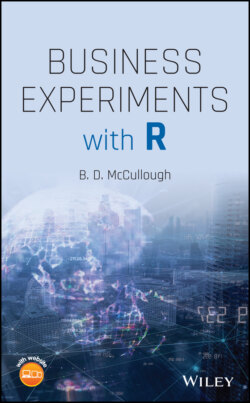Читать книгу Business Experiments with R - B. D. McCullough - Страница 43
Section 1.5 “Improving Website Design”
ОглавлениеAll the web tests, in particular the results in Table 1.6, are real. Due to difficulties obtaining permissions for the original web ads, some of the web ads were mocked‐up to simulate the real ads. The photograph in Figure 1.5 is from pixabay.com, and the photograph in Figure 1.7 is from pexels.com.
GuessTheTest.com is a resource for digital marketers who want objective A/B test case studies and helpful information to get split‐testing ideas, insights, and best practices. There are many aspects of A/B testing on the web that are not covered in this book, and the interested reader may profitably spend some time at this website. Also, if you think you're any good at predicting the outcome of an A/B web test, to disabuse yourself of such an errant notion, try guessing at a dozen or so of the many cases presented at this website and see if you can beat 50% accuracy by a statistically significant amount.
• We barely scratched the surface of A/B testing, which, according to two recent surveys, is the most important topic in business: a survey of online marketers found “Conversion Rate Optimization” to be a top priority for the foreseeable future (SalesForce.com, 2014); a survey of businesses that engage in conversion rate optimization used A/B testing more than any other method (Econsultancy, 2015).
• An entertaining layman's article on the rise of A/B testing can be found in Wired magazine (Christian, 2012). On A/B testing and the Obama presidential campaigns, see the interesting article in Bloomberg Businessweek by Joshua Green (2012). This is of historical interest because the Obama campaign was the first to really use analytics for fundraising and get‐out‐the‐vote activities. For those who want to learn more about the technology behind website testing and the types of tests that are possible on websites, we recommend the chapter on web testing in Waisberg and Kashuk's book titled Web Analytics 2.0 (Waisberg and Kaushik, 2009) or the succinct book by McFarland (2012) with the catchy title Experiment!.
There are also numerous other books with more in‐depth coverage of website experiments such as Siroker and Koomen (2013). Technology tools for website testing are rapidly evolving, and the evaluation of software tools is a critical first step in any website testing program. A good article on the mechanics of A/B testing on the web is Kohavi et al. (2009b). He also co‐authored an informative article, “Trustworthy Online Controlled Experiments: Five Puzzling Outcomes Explained” (Kohavi et al., 2012), as well as “Seven Rules of Thumb for Web Site Experimenters” (Kohavi et al., 2014).
